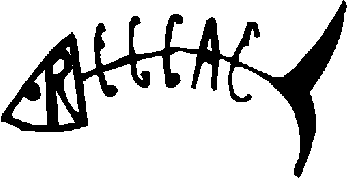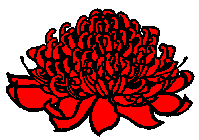|
[Front Page] [Features] [Departments] [SGAP Home Page] [Subscribe]

First Cuttings
Holy Mackerel!!
For those who like their plant propagation methods to push the boundaries of logical thought, the following extract from the newsletter of SGAP's Epacris Study Group (March 1999) will both amaze and mystify.....
"The Smoked Kipper Method"
 
"There are obviously numerous methods of achieving the 'smoking process' in seed germination. One of the more unusual ones passed on to us by an English friend was to obtain a smoked kipper, soak it in water, then use that water to soak the seed in, or for watering in the seed after planting. Those who enjoy a smoked kipper for breakfast will undoubtedly gain a double bonus in using this method!"
Presumably smoked salmon will work as well.........

Cultivar Watch
Have you seen some of the new cultivars of Banksia spinulosa (hairpin banksia) that are reaching the market? They're fantastic....but I think all plants would be banksias if they could be so I may be biased!
I recently spent a few weeks managing a native plant nursery for friends while they took a well earned break. It was a great experience for many reasons but particularly interesting to talk to people about the plants that they wanted to grow in their gardens. The most popular plants by a long margin were the new small banksias like "Birthday Candles", "Coastal Cushion", "Snapper Point" and "Stumpy Gold" (pity about the names...but that's marketing!). The first three mentioned are all very similar, growing to about half a metre high by about a metre wide with conspicuously displayed orange flower spikes. The three of them have been selected from plants growing on coastal headland of the New South Wales south coast.
 |
Banksia spinulosa "Birthday Candles" is one of several small growing cultivars of the "Hairpin banksia" which are becoming very popular in cultivation.
Select the thumbnail image or plant name for a higher resolution image (31k) Photo: Australian Plants journal
|
If you haven't come across any of these yet, watch out for them. They are hardy, spectacular, great for small gardens and look magnificent in a container .

Information Sheets
 
This series of 10 Information Sheets was developed by the Australian Plants Society (NSW) to provide practical information for members in a permanently available form. They have now been compiled into a booklet and are available generally at $10 per copy, including postage in New South Wales.
The Information Sheets mainly cover NSW issues but some are of more general interest:
- 1. Establishing an Australian Plant Garden or Nature Area in a School
- Written from a teacherís point of view, the Information Sheet is a guide to planning and organisation, fund raising and educational activities, construction, plant selection and planting out, windbreaks, pond or bog areas.
- 2. Flowers
- An introduction to the botany of a flower, with an activity to provide experience.
- 3. Reliable Plants for the Sydney Region
- A two page list divided into sections on trees, screen plants and windbreaks, plants for heavy clay soils, plants for sandy soils, plants for light shade, plants for wet shade, plants for dry shade, plants for moist sun and ground covers. A mini "Grow What Where" for Sydney.
- 4. Botanical Keys
- A list of some of the best known keys to Australian plants and hints on how to become skilled in using them. Four practical exercises are included to help the learning process.
- 5. Keeping Cutflowers Fresh
- Instructions from an expert on how to make your Australian cut flowers last longer.
- 6. Propagate Your Own Native Plants
- This is a reissue, with some revision and a further reading list, of the Societyís previous leaflet.
- 7. Green Corridors
- Basic information about the function, design and planning of green corridors with a further reading list.
- 8. Register Your Cultivar with ACRA
- Instructions on how to register a cultivar with the Australian Cultivar Registration Authority (not Plant Breeders' Rights).
- 9. Lists of Threatened Plants, Populations and Communities
- How to locate New South Wales, interstate, national and international lists with information about definitions, administration and new listings.
- 10. Collection of Specimens and Propagules Laws
- The laws that apply to collection of native plant specimens and propagating material.
The complete set of Information Sheets is available from:
Australian Plants Society (NSW)
PO Box 744
Blacktown, NSW, 2148

A New Broom.....
A report in the May - July 1999 issue of "Bush Telegraph", a publication of NSW State Forests, reports on biological control of the noxious weed Scotch broom (Cytissus scoparia). This spectacular yellow, pea-flowered shrub has long outlived its welcome in Australia. In the Barrington Tops area north of Newcastle, some 11,000 hectares of public and private lands have been infested with the pest and it causes equal havoc in many other areas. Studies have shown that the weed produces a soil "seed bank" of up to 7000 seeds per square metre!
Moving onto the front line of warfare against broom is a small twig-mining moth, Leucoptera. This was first released in 1993 and their numbers have been recently topped up. Because broom is so well entrenched, the moth is only likely to have a significant effect in the long term. In the meantime, herbicide treatment will remain an important weapon is curbing its spread.

The Causes of Bushfires
An article in "NPWS News" (published by the National Parks and Wildlife Service, NSW) on the use of technology to detect fires caught my attention, not just for the article itself but for an accompanying diagram which showed the causes of bushfires. I've changed it from a pie chart to a bar chart and you might find it interesting too.....

Good growing
Brian Walters

[Front Page] [Features] [Departments] [SGAP Home Page] [Subscribe]
Australian Plants online - June 1999
Association of Societies for Growing Australian Plants
|